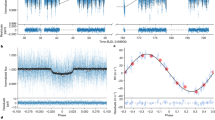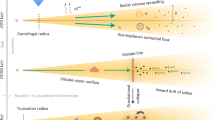Abstract
Planets with sizes between that of Earth (with radius  ) and Neptune (about 4
) and Neptune (about 4 ) are now known to be common around Sun-like stars1,2,3. Most such planets have been discovered through the transit technique, by which the planet’s size can be determined from the fraction of starlight blocked by the planet as it passes in front of its star. Measuring the planet’s mass—and hence its density, which is a clue to its composition—is more difficult. Planets of size 2–4
) are now known to be common around Sun-like stars1,2,3. Most such planets have been discovered through the transit technique, by which the planet’s size can be determined from the fraction of starlight blocked by the planet as it passes in front of its star. Measuring the planet’s mass—and hence its density, which is a clue to its composition—is more difficult. Planets of size 2–4 have proved to have a wide range of densities, implying a diversity of compositions4,5, but these measurements did not extend to planets as small as Earth. Here we report Doppler spectroscopic measurements of the mass of the Earth-sized planet Kepler-78b, which orbits its host star every 8.5 hours (ref. 6). Given a radius of 1.20 ± 0.09
have proved to have a wide range of densities, implying a diversity of compositions4,5, but these measurements did not extend to planets as small as Earth. Here we report Doppler spectroscopic measurements of the mass of the Earth-sized planet Kepler-78b, which orbits its host star every 8.5 hours (ref. 6). Given a radius of 1.20 ± 0.09 and a mass of 1.69 ± 0.41
and a mass of 1.69 ± 0.41 , the planet’s mean density of 5.3 ± 1.8 g cm−3 is similar to Earth’s, suggesting a composition of rock and iron.
, the planet’s mean density of 5.3 ± 1.8 g cm−3 is similar to Earth’s, suggesting a composition of rock and iron.
This is a preview of subscription content, access via your institution
Access options
Subscribe to this journal
Receive 51 print issues and online access
$199.00 per year
only $3.90 per issue
Buy this article
- Purchase on Springer Link
- Instant access to full article PDF
Prices may be subject to local taxes which are calculated during checkout


Similar content being viewed by others
References
Howard, A. W. et al. Planet occurrence within 0.25 AU of solar-type stars from Kepler. Astrophys. J. 201 (Suppl.). 15 (2012)
Petigura, E., Marcy, G. W. & Howard, A. A plateau in the planet population below twice the size of Earth. Astrophys. J. 770, 69 (2013)
Fressin, F. et al. The false positive rate of Kepler and the occurrence of planets. Astrophys. J. 766, 81 (2013)
Valencia, D., Guillot, T., Parmentier, V. & Freedman, R. S. Bulk composition of GJ 1214b and other sub-Neptune exoplanets. Astrophys. J. 775, 10 (2013)
Fortney, J. J. et al. A framework for characterizing the atmospheres of low-mass low-density transiting planets. Astrophys. J. 775, 80 (2013)
Sanchis-Ojeda, R. et al. Transits and occultations of an Earth-sized planet in an 8.5-hour orbit. Astrophys. J. 774, 54 (2013)
Borucki, W. J. et al. Kepler planet-detection mission: introduction and first results. Science 327, 977–980 (2010)
Vogt, S. et al. HIRES: the high-resolution echelle spectrometer on the Keck 10-m telescope. Proc. SPIE 2198, 362–375 (1994)
Butler, R. P. Attaining Doppler precision of 3 m s−1. Publ. Astron. Soc. Pacif. 108, 500–509 (1996)
Pepe, F. et al. An Earth-sized planet with an Earth-like density. Nature http://dx.doi.org/10.1038/nature12768 (this issue)
Fortney, J. J. et al. Planetary radii across five orders of magnitude in mass and stellar insolation: application to transits. Astrophys. J. 659, 1661–1672 (2007)
Hauck, S. A., II et al. The curious case of Mercury’s internal structure. J. Geophys. Res. 118, 1204–1220 (2013)
Lopez, E. D., Fortney, J. J. & Miller, N. How thermal evolution and mass-loss sculpt populations of super-Earths and sub-Neptunes: application to the Kepler-11 system and beyond. Astrophys. J. 761, 59 (2012)
Perez-Becker, D. & Chiang, E. Catastrophic evaporation of rocky planets. Mon. Not. R. Astron. Soc. 433, 2294–2309 (2013)
Rappaport, S. et al. Possible disintegrating short-period super-Mercury orbiting KIC 12557548. Astrophys. J. 752, 1 (2012)
Jackson, B., Stark, C. C., Adams, E. R., Chambers, J. & Deming, D. A survey for very short-period planets in the Kepler data. Astrophys. J. (submitted); preprint at http://arxiv.org/abs/1308.1379 (2013)
Muirhead, P. S. et al. Characterizing the cool KOIs. III. KOI 961: a small star with large proper motion and three small planets. Astrophys. J. 747, 144 (2012)
Ofir, A. & Dreizler, S. An independent planet search in the Kepler dataset. I. One hundred new candidates and revised Kepler objects of interest. Astron. Astrophys. 555, A58 (2013)
Rappaport, S. et al. The Roche limit for close-orbiting planets: minimum density, composition, and application to the 4.2 hr planet KOI 1843.01. Astrophys. J. 773, L15 (2013)
Lissauer, J. J. et al. All six planets known to orbit Kepler-11 have low densities. Astrophys. J. 770, 131 (2013)
Valenti, J. A. & Fischer, D. A. Spectroscopic properties of cool stars (SPOCS). I. 1040 F, G, and K dwarfs from Keck, Lick, and AAT planet search programs. Astrophys. J. 159 (Suppl.). 141–166 (2005)
Dotter, A. et al. The Dartmouth stellar evolution database. Astrophys. J. 178 (Suppl.). 89–101 (2008)
Torres, G., Andersen, J. & Giménez, A. Accurate masses and radii of normal stars: modern results and applications. Astron. Astrophys. Rev. 18, 67–126 (2010)
Seager, S. et al. Mass-radius relationships for solid exoplanets. Astrophys. J. 669, 1279–1297 (2007)
Wright, J. T. et al. The exoplanet orbit database. Publ. Astron. Soc. Pacif. 123, 412–422 (2011)
Valenti, J. & Piskunov, N. Spectroscopy made easy: a new tool for fitting observations with synthetic spectra. Astron. Astrophys. 118 (Suppl.). 595–603 (1996)
Boyajian, T. S. et al. Stellar diameters and temperatures. II. Main-sequence K- and M-stars. Astrophys. J. 757, 112 (2012)
Torres, G., Winn, J. N. & Holman, M. J. Improved parameters for extrasolar transiting planets. Astrophys. J. 667, 1324 (2012)
Henry, G. W. & Winn, J. N. The rotation period of the planet-hosting star HD 189733. Astron. J. 135, 68–71 (2008)
Bouchy, F. et al. ELODIE metallicity-biased search for transiting hot Jupiters II. A very hot Jupiter transiting the bright K star HD 189733. Astron. Astrophys. 444, L15–L19 (2005)
Mamajek, E. E. & Hillenbrand, L. A. Improved age estimation for solar-type dwarfs using activity-rotation diagnostics. Astrophys. J. 687, 1264–1293 (2008)
Jones, B. F., Fischer, D. & Shetrone, M. The evolution of the lithium abundances of solar-type stars. VII. M34 (MGC 1039) and the role of rotation in lithium depletion. Astron. J. 114, 352–362 (1997)
Seager, S. & Mallén-Ornelas, G. A unique solution of planet and star parameters from an extrasolar planet transit light curve. Astrophys. J. 585, 1038–1055 (2003)
Mandel, K. & Agol, E. Analytic light curves for planetary transit searches. Astrophys. J. 580, L171–L175 (2002)
Batalha, N. et al. Kepler’s first rocky planet: Kepler-10b. Astrophys. J. 729, 27 (2011)
Marcy, G. W. & Butler, R. P. Precision radial velocities with an iodine absorption cell. Publ. Astron. Soc. Pacif. 104, 270–277 (1992)
Valenti, J. A., Butler, R. P. & Marcy, G. W. 1995, Determining spectrometer instrumental profiles using FTS reference spectra. Publ. Astron. Soc. Pacif. 107, 966–976 (1995)
Isaacson, H. & Fischer, D. Chromospheric activity and jitter measurements for 2630 stars on the California planet search. Astrophys. J. 725, 875–885 (2010)
Chubak, C. et al. Precise radial velocities of 2046 nearby FGKM stars and 131 standards. Astrophys. J.. (submitted); available at http://arxiv.org/abs/1207.6212 (2012)
Dumusque, X. et al. An Earth-mass planet orbiting α Centauri B. Nature 491, 207–211 (2012)
Johnson, J. A. et al. Retired A stars and their companions. VII. 18 new jovian planets. Astrophys. J. 197 (Suppl.). 26 (2012)
Hatzes, A. P. et al. The Mass of CoRoT-7b. Astrophys. J. 743, 75 (2011)
Pecaut, M. J., Mamajek, E. E. & Bubar, E. J. A revised age for upper Scorpius and the star formation history among the F-type members of the Scorpius-Centaurus OB association. Astrophys. J. 746, 154 (2012)
Acknowledgements
This Letter and another10 were submitted simultaneously and are the result of coordinated, independent radial-velocity observations and analyses of Kepler-78. We thank the HARPS-N team for their collegiality. We also thank E. Chiang, I. Crossfield, R. Kolbl, E. Petigura, and D. Huber for discussions, S. Howard for support, C. Dressing for a convenient packaging of stellar models, and A. Hatzes for a thorough review. This work was based on observations at the W. M. Keck Observatory granted by the University of Hawaii, the University of California, and the California Institute of Technology. We thank the observers who contributed to the measurements reported here and acknowledge the efforts of the Keck Observatory staff. We thank those of Hawaiian ancestry on whose sacred mountain of Mauna Kea we are guests. Kepler was competitively selected as the tenth Discovery mission with funding provided by NASA’s Science Mission Directorate. J.N.W. and R.S.-O. acknowledge support from the Kepler Participating Scientist programme. A.W.H. acknowledges funding from NASA grant NNX12AJ23G.
Author information
Authors and Affiliations
Contributions
This measurement was conceived and planned by A.W.H., G.W.M., J.A.J., J.N.W. and R.S.-O. HIRES observations were conducted by A.W.H., G.W.M., H.I, B.J.F. and E.S. The HIRES spectra were reduced and Doppler-analysed by A.W.H., G.W.M., H.I. and J.A.J. Data modelling was done primarily by A.W.H. and R.S.-O. A.W.H. was the primary author of the manuscript, with important contributions from J.N.W., R.S.-O. and J.J.F. Figures were generated by A.W.H., R.S.-O, B.J.F. and E.S. All authors discussed the results, commented on the manuscript and contributed to the interpretation.
Corresponding authors
Ethics declarations
Competing interests
The authors declare no competing financial interests.
Extended data figures and tables
Extended Data Figure 1 Wavelength-calibrated spectra of three stars near the age-sensitive Li i line (6,708 Å).
This line is not detected in the Kepler-78 spectrum, suggesting that lithium has been depleted, consistent with an age exceeding half a billion years for this K0 star. The lithium line is also not detected in the 4.6-billion-year-old Sun. (Gyr, billion years; Myr, million years.) It is clearly seen in the rotationally broadened spectrum of [PZ99] J161618.0 − 233947, a star whose spectral type (G8) is similar to that of Kepler-78, but that is much younger (about 11 million years)43. Additional iron and calcium lines are labelled.
Extended Data Figure 2 Correlations between model parameters in the transit analysis.
Greyscale contours denote confidence levels, with thick black lines highlighting the 1σ, 2σ and 3σ contour levels. The strongest correlations are between transit depth, scaled semi-major axis and impact parameter.
Extended Data Figure 3 Apparent radial-velocity variations of Kepler-78 for the offset-slope model.
The top panel shows the complete 45-day time series of relative radial velocities (red filled circles). Eight grey boxes highlight nights of intensive observations. The measurements from these nights are shown in the eight subpanels. In each subpanel, the radial velocities (red filled circles) and best-fit offset-slope model (solid black line) are shown. The radial-velocity curves for 100 randomly selected models from the MCMC chain are underplotted in grey, showing the range of variation within the model distribution.
Supplementary information
Supplementary Tables
This file contains Supplementary Table 1, which shows time series radial velocity measurements and associated activity measurements. (PDF 145 kb)
PowerPoint slides
Rights and permissions
About this article
Cite this article
Howard, A., Sanchis-Ojeda, R., Marcy, G. et al. A rocky composition for an Earth-sized exoplanet. Nature 503, 381–384 (2013). https://doi.org/10.1038/nature12767
Received:
Accepted:
Published:
Issue Date:
DOI: https://doi.org/10.1038/nature12767
This article is cited by
-
Hydrogen Dominated Atmospheres on Terrestrial Mass Planets: Evidence, Origin and Evolution
Space Science Reviews (2020)
-
Future Missions Related to the Determination of the Elemental and Isotopic Composition of Earth, Moon and the Terrestrial Planets
Space Science Reviews (2020)
Comments
By submitting a comment you agree to abide by our Terms and Community Guidelines. If you find something abusive or that does not comply with our terms or guidelines please flag it as inappropriate.



